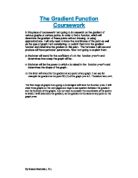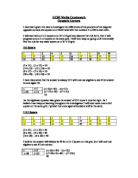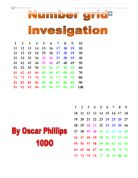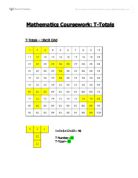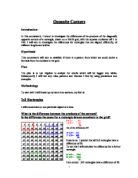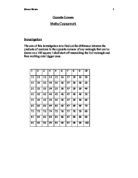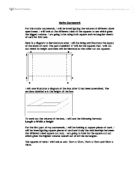Open Box Investigation
25th January Math | Sara Ellis Introduction: The open box problem is regarding an open box made from a sheet of card. Identical sized squares are removed from the four corners of the card (shown in the diagram below). The aim of this investigation is to verify the size of the square removed that would make the largest volume for any given sheet of card, both square and rectangular. I will do this by finding a general formula which would work for finding the best size of square cut. Square Boxes In order to determine the size of square cut off from the card, I tried many different sizes on square boxes to find the size that would give the largest volume. To find the volume I have used the formula: Volume = Length x Width x Height To find the length and width I take two of the length of square cut from the total length/width of the box. The height is the same as the side length of square cut. Below are my results: 0x10 Square Side Length of Square (cm) 2 3 4 Length of Box 8 6 4 2 Width of Box 8 6 4 2 Height 2 3 4 Volume 64 72 48 6 To find the more precise length of square which I should cut, I have used the upper and lower bounds of the best length of square in the table above (in this case, 2cm). Side Length of Square .5 .6 .7 .8 .9 2 2.1 Length of Box 7 6.8 6.6 6.4 6.2 6 5.8 Width of Box 7 6.8 6.6 6.4 6.2 6 5.8
T-total coursework
Part 1 Investigate the relationship between the T-total and the T-number 2 3 4 5 6 7 8 9 0 1 2 3 4 5 6 7 8 9 20 21 22 23 24 25 26 27 28 29 30 31 32 33 34 35 36 37 38 39 40 41 42 43 44 45 46 47 48 49 50 51 52 53 54 55 56 57 58 59 60 61 62 63 64 65 66 67 68 69 70 71 72 73 74 75 76 77 78 79 80 81 2 3 0 1 2 9 20 21 The T-number is always the number at the bottom of the T, so in this case (the yellow T) it is 20. The sum of all the numbers in the T is the T-total. In this case, the T-number, (which will now be called n) is 20, and the T-total, (which will now be called T) is 37. If the number at the bottom of the T is n, these are the other numbers in terms of n, bearing in mind that the width of the grid is 9 (by 9): n-19 n-18 n-17 0 n-9 2 9 n 21 The number above the T-number is (n-9) because this number is exactly one row above (n). The width of the grid is 9, so by moving up 1 cell from (n), I am decreasing the value by the width of the grid (9). The cell above (n-9) is (n-18) as the value has been decreased by the width of the grid again. The cell to the left of (n-18) is (n-19) as it has been decreased by 1. The cell to the right of (n-18) is (n-17) as it is 1 more than (n-18). When these 5 terms are added together I get: (n) + (n-9) + (n-17) + (n-18) + (n-19) = 5n - 63
The Gradient Function Coursework
The Gradient Function Coursework In this piece of coursework I am going to do research on the gradient of various graphs at various points, in order to find a function, which will determine the gradient of these points without drawing or using approximations. I will only need to know the coordinates of the point as well as the type of graph I am considering, to submit them into the gradient function and determine the gradient at this point. The formulae I will use and produce will have particular parameters. Now I am going to explain them. a: this letter will stand for the coefficient of x in the function y=ax^n and determines how steep the graph will be. n: this letter will be the power to which x is raised in the function y=ax^n and determines the shape of the graph. m: this letter will stand for the gradient at any point of any graph. I can say for example the gradient at the point P(1;1) of the graph y=x is 1. Therefore here m=1. The first range of graphs I am going to investigate will have the function y=ax. I will draw three graphs on the next pages and hope to see a pattern between the gradient and the function of the graphs. I do not need to consider the coordinates of the points at which I will determine the gradient, as the gradient is the same at any point on the graph y=ax. From these three graphs I clearly recognise a pattern. I will show how I noticed
opposite corners
GCSE Maths Coursework Opposite Corners I have been given the task to investigate the differences of the products of the diagonal opposite corners of a square on a 10x10 Grid with the numbers 1 to 100 to start with. I will start with a 2 x 2 square on a 10 x 10 grid and discover the rule for it, then I will progress onto a 3 x 3 square on the same grid. I will then keep on going until I eventually find the rule for any sized square on a 10 x 10 grid. 2x2 Square 2 3 4 5 6 7 8 9 0 1 2 3 4 5 6 7 8 9 20 21 22 23 24 25 26 27 28 29 30 (2 x 11) - (1 x 12) = 10 (14 x 25) - (15 x 24) = 10 (8 x 17) - (7 x 18) = 10 (20 x 29) - (19 x 30) = 10 I have discovered that the answer is always 10 I will now use algebra to see if the answer is once again 10. n n+1 n+10 n+11 (n+1)(n+10) - n(n+11) (n2+11n+10) - (n2+11n) 0 As the algebraic equation also gives the answer of 10 I know it must be right. As I believe I can keep on learning throughout the investigation I will now move onto a 3x3 square on the same grid. I predict that once again all answers will be the same. 3 X 3 Square 2 3 4 5 6 7 8 9 0 1 2 3 4 5 6 7 8 9 20 21 22 23 24 25 26 27 28 29 30 (3 x 21) - (1 x 23) = 40 (6 x 24) - (4 x 26) = 40 (10 x 28) - (8 x 30) = 40 I believe the answer will always be 40 for a 3 x 3 square on this grid. So I will now use algebra





